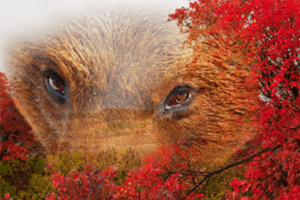When the days shorten and temperatures fall, the season of autumn begins, most noticeably with the changing color and falling of leaves. As plants stop making what gives them their green color, chlorophyll, due to the colder and darker weather, they instead break it down into smaller molecules, changing the leaves from green into shades of yellow, orange, red, and purple with the carotenoid and anthocyanin pigments accumulating in the leaves in the absences of the chlorophyll. If plants can break down and move the chlorophyll out of the leaves before the leaves fall, they save energy by reabsorbing the molecules that make up chlorophyll so when it is sunnier again, they do not have to start from the beginning to make chlorophyll, as it takes a lot of energy to do so.
 While some like to believe that old Jack Frost has a hand in changing leaf colors, long before this legend and modern science, Native American tribes had other explanations for the beautiful fall leaf colors we experience every year. Enjoy reading summaries of some of these ancient Native American legends about why the leaves change color or why they fall (see links below for the full stories!):
While some like to believe that old Jack Frost has a hand in changing leaf colors, long before this legend and modern science, Native American tribes had other explanations for the beautiful fall leaf colors we experience every year. Enjoy reading summaries of some of these ancient Native American legends about why the leaves change color or why they fall (see links below for the full stories!):
The Algonquin believed that there was once a great bear threatening the people of the tribe, by eating their food, destroying their homes, and mauling their women and children. Warriors from several tribes had to come together to hunt it, chasing the bear for months over mountains and seas. One arrow finally pierced the bear but did not kill it. The pain caused the bear to rear up to the heavens where it is still chased by the warriors to this day around the earth. In autumn, the bear rises above the horizon, dripping its blood onto the trees below, causing them to change color.
A similar Haudenosaunee legend also includes a great bear that was stealing the animals the villagers relied on as food. As hunger increased, many parties of warriors went out to kill the bear but failed. Three brothers for three nights had the same recurring dream that they would track and kill the bear. After setting off, they tracked the bears to the end of the earth, following it into the heavens as it leaped from the earth into the sky. The three brothers are still chasing it to this day, and as the bear slows down in the fall to prepare for its winter sleep, the brothers are able to get close enough to injure the bear with arrows, causing the blood to drip down and paint the leaves of fall. Both legends state that the bear reappears in the sky as the Big Dipper, with the warriors still chasing him (they are the handle).
 Other similar myths say that celestial hunters do capture the bear each fall, changing the leaves to red from the bears blood, but also as the hunters cook the bear, the fat that spatters out of the great kettle in the sky color the leaves yellow or turn the grass white!
Other similar myths say that celestial hunters do capture the bear each fall, changing the leaves to red from the bears blood, but also as the hunters cook the bear, the fat that spatters out of the great kettle in the sky color the leaves yellow or turn the grass white!
A Lakota legend states that as the winter weather approached, the “grass and flower folk were in sad condition, for they had no protection from the sharp cold.” Then, “he who looks after the things of His creation came to their aid,” by telling the leaves of the trees to fall to the ground to create a warm blanket to protect the roots of the grass and flowers. To repay the trees, he let them have “one last bright array of beauty.” Therefore, every Indian summer, the leaves fall after their display of “farewell colors” to follow their “appointed task-covering the Earth with a thick rug of warmth against the chill of winter.”
A Wyandot (Huron) legend also involves a bear, along with a deer. The selfish Bear who “often made trouble among the Animals of the Great Council” sought out the Deer who had walked over the Rainbow Bridge into the sky land. The Bear said to the Deer, “This sky land is the home of the Little Turtle. Why did you come into this land? Why did you not come to meet us in the Great Council? Why did you not wait until all the Animals could come to live here?” The Deer became angry, believing that only the Wolf could ask these questions. The Deer tried to kill the Bear with his horns, tearing into him, as they fought. The noise from the battle urged the Wolf into the sky to stop the fighting, and both animals fled. The blood of the Bear fell from the Deer’s horns onto the leaves below, changing them to red, yellow, brown, scarlet, and crimson. Each year the leaves take on the multitude of colors, and the Wyandots say “the blood of the Bear has again been thrown down from the sky upon the trees of the Great Island.”
While these are probably only a few of the myths and variations of past reasonings behind the changing of the leaves, they are beautiful stories and a lasting part of Native American history and legends. I hope you enjoyed these small summaries and pause to appreciate the gorgeous, colorful leaves this fall!
Follow IUP Anthropology on Facebook, Twitter, and Instagram